Imagine you’ve decided to become a clinically specialized interior designer. You’re pitching a television show to HGTV on making over and renovating patient rooms in hospitals so that the patients (and their visitors) are comfortable, encouraged and protected from infection as they heal, and also the caregivers are safe from harm, too.
In the back of your mind, you’re motivated by an intriguing thought: What if patients could select their hospitals based on room amenities, similar to how they might book their hotel rooms or buy houses – minus the pricing angle as the payer, by and large, determines that measure?
For either an inpatient hospital stay or even an outpatient exam room, you’d likely home in on comfort, convenience, safety and user-friendliness.
Comfort
Based on the utilitarian philosophy of form follows function, patient and exam rooms really haven’t followed the example of the hospital vestibules and welcome areas lavished with baby grand player pianos, cascading waterfalls, commissioned paintings and sculptures, giant wall-mounted flat screens, lush greenery and whiffs of cucumber melon, lavender pine or vanilla nut scents.
Nor should they.
Save for the birth of a child, visiting a relative or friend or expecting a clean bill of health, few want to experience the compounding stress of walking into a hospital so administrators try to make the initial experience as pleasant as possible.
The same should apply to the frequent and extended experiences, too. One of the key strategies seems to be redesigning the visiting, frequent and extended stay areas much like familiar environments.
Providing enough room for family members to be with their loved one during their stay should also be a top priority, Kantz insisted.
“Nothing is more comforting than having family nearby, so providing a space for loved ones to sit comfortably and possibly work will help put the patient at ease,” she noted. “Finally, a space that is customized to the patient helps alleviate some of the anxiety over their hospital stay. Providing the patient with a pre-arrival survey allows the staff to provide them with some of their favorite foods, reading materials or preferred TV channels.”
One difference between home and a patient or exam room is the element of control.
“It’s also important to think of the comfort of family members,” Saettel continued. “I’d want to have a comfortable seating – and maybe sleeping – area for visitors. Family and friends often want to spend time with patients and providing visitors a comfortable space can help patients not to feel like a burden. Any additional amenities, such as access to entertainment, would make the experience better and more comfortable. From offering the latest movies via tablet technology to something as small as extra pillows, details make everything more comfortable.”
Ann Schiffers, Senior Vice President of Specification Sales, USAI Lighting, prefers to look up and around – with a feel of the outdoors.
“Lighting would be my first effort in re-design,” Schiffers suggested. “Tunable lighting that changes to become warmer and cooler — much like the sun changes over the course of the day — adding comfort to the space by providing light the way we have always naturally experienced it while outdoors on a beautiful sunny day in our favorite place. The lighting would become warm and dim to comfort the occupants and allow for great relaxation and sleep and fade up and down when turned on or off slowly. Furthermore the patient would have easy control — from bed — of their lights, shades, air temperature, music and anything else that would allow them to personalize their space to their preferences. By helping patients feel more comfortable we can help speed up the healing and recovery process.”
On the other hand, Sandra Soraci, EDAC, LEED AP, NCIDQ, Marketing Strategy Lead, Healthcare & Education, Interface, casts her gaze down and around.
Just like open floor plans seem popular with contemporary homebuyers, space for maneuverability and mobility remains a premium in patient and exam rooms, which can be crammed with cabinetry and equipment.
The living room focal point for many homes historically tends to be a decorative feature wall, fireplace or oversized bay or bow window, but consumers the 21st century have added another component into the mix: A flat-screen television.
“Like the TV in your living room, the bigger the better,” Mottlau insisted. “Larger-screen hospital TVs can be used for more than traditional television entertainment, including relaxation channels with soothing music and content. New hospital TVs can deliver services specific to the patient needs. LG’s Pro:Centric WebOS platform, for example, offers Patient Engagement systems that enable the patient to interact with the TV as part of their “care plan.” Patient education videos help you learn about your specific condition and support their road to recovery. These kinds of ‘patient engagement’ offerings are all developed by systems integrator partners for our secure Pro:Centric platform.”
Convenience
Some may define convenience by what it is not – annoying, irritating, restrictive and helpless. Instead, it’s accessible, easy and therefore, stress-free.
Putting everything within easy reach of the patient is a must for convenience, emphasized PDi’s Saettel. That includes both a wall TV and a bedside entertainment system to deliver “the utmost versatility” for pediatric or any patients and their visitors.
“When they actually have a moment to themselves with no busy nurses or caring family members, you don’t want the patients to realize that they can’t reach something they need,” noted Lynn Schutte, Marketing Communications Coordinator, PDi. “Whether it’s adding an extra bedside table or bringing the television within arm’s reach, giving patients access to the things they need makes their time more convenient, reduces boredom and frustrations, and, also, gives them a sense of control.”
Access to what’s needed for mobility remains constant, according to HoverTech’s Kramer.
“Caregivers transfer and reposition patients constantly and having the right equipment available to perform these tasks makes a difference in their ability to provide excellent care,” she said. “Products that can remain with the patient for all-day care are ideal so that staff do not have to search for equipment and place it before each patient-handling task. Rooms should also be outfitted with products that are multi-functional to improve staff efficiency, while reducing costs for additional equipment. If one product can transfer, turn and boost a patient, product selection is simplified for caregivers. Making daily tasks easier and more convenient translates into higher staff satisfaction, which is a great indication of patient satisfaction.”
Determining where to go may be near the top of the list of convenience attributes, and visual cues may offer welcome assistance, insists Sherwin-Williams’ Kantz.
“Wayfinding is one of the easiest ways to turn a typical visit into a stressful visit, from both the patient and caregiver perspective,” she said. “Color is the perfect indicator to help guide someone through a healthcare campus. For example, the staff can easily say, ‘Make a left at the deep blue wall, you will find the elevator bank. The nurse station has a deep orange soffit that you can find from the corridor.’ These visual cues help ease stress and help aid in the convenience for the patients and their caregivers to locate their destinations in a timely manner.”
Also near the top of the list of convenience attributes is not having to wait for access or service.
“Perhaps one of the biggest inconveniences for healthcare providers and their patients is the time required to turn over a patient room,” said Interface’s Soraci. “As 24/7 operations, hospitals do not have the luxury of downtime, so spaces need to be made-ready for the next patient as quickly as possible. Therefore, an improved patient room should allow for an efficient, low-maintenance cleaning regiment, while simultaneously avoiding the use of harsh chemicals and without sacrificing the strict hygienic standards of healthcare environments.”
USAI Lighting’s Schiffers envisions the ultimate in convenience – speaking something into existence.
“Every user-controlled feature would have the option to be voice-controlled, such as lights, shades, air, bed angle tilt, music and television,” she noted. “For multi-day stays, the data would be saved to repeat 24 hours automatically but with another unique feature — sleep mode detection of the patient, much like our devices today have sleep mode. The patient would be monitored, and once they drifted off to sleep all features would be ‘tuned’ to automatically shift slowly to optimize sleep, such as dim lights, 68-degree room temperature, shades down, etc.”
Schiffers then pivoted to the dominant piece of equipment in the room.
“While we’re at it, we should provide top-of-the-line mattresses that are incredibly comfortable, like Westin’s ‘Heavenly Bed,’ and upgrade them to have heating, cooling and massage features,” she suggested. “The crux of all of this is optimized comfort and healing. There’s no reason why our ‘everyday’ items can’t be as smart, luxurious or properly equipped as some of our top-tier automobiles.”
LG’s Mottlau focuses on the TV as more of a tool than just a toy.
“The hospital TV can eliminate much of the paperwork by having the patient use the TV to fill out forms and surveys,” he said. “The TV can also be used to order culinary choices, order gift shop items or aid in memory care.”
Safety
Any hospital room redesigns must keep safety in the forefront for caregivers, patients and visitors. That involves such capabilities as ergonomics and infection resistance.
“New equipment and technology is making it easier to create seamless experiences and reduce safety issues at the point of care in the ambulatory care patient exam room,” said Kurt Forstheofel, Marketing Director, Midmark. “There are exam chairs that lower to accommodate patients with mobility issues, equipment designed with ergonomic principles to eliminate unnecessary straining and technology that can help track exposure to contagions.”
Forstheofel cites patient exam chairs capable of lowering to a height of 15.5 inches that allow most patients to access the chair with little or no assistance as one example. Another is real-time location system (RTLS) technology and mobile workstations that can link to electronic health/medical records, diagnostic devices and decision support tools and improve utilization and workflow.
“Even though CMS classifies them as preventable incidents that should never occur in healthcare facilities, slips, trips and falls are some of the most common adverse events reported in hospitals,” said Interface’s Soraci. “Not surprisingly, these incidents are directly related to flooring selection. When designing an optimal patient room, specifying flooring that offers a seamless, cushioned, slip-resistant surface can help minimize these costly, preventable events.”
Maneuverability and mobility also can contribute to harm and injury if not performed properly, according to HoverTech’s Kramer.
“Protecting patient and caregiver safety has to be top of mind when designing a patient room,” she said. “Every effort should be made to eliminate manual handling and to use assistive devices to perform tasks that may put staff or patients at risk. NIOSH recommendations state that caregivers should not lift more than 35 lbs.”
PDi’s Saettel zeroes in on the potential dangers and hazards of mobile devices.
“In terms of infection control, the idea of added distraction from a personal tablet is great, however, many patients don’t want to risk bringing their own devices into a hospital, and sharing consumer-grade tablets across patients is worrisome,” she said. “Not to mention the risk of fire from charging consumer devices and trip hazards from personal charging cords. Rather, healthcare-grade arm-mounted bedside devices with antimicrobial surfaces that can be wiped down using bleach solutions would make patients happy! Arm-mounted bedside devices can also easily be pushed out of the way in the event of a medical necessity with no worries of a personal tablet falling from the bed and getting damaged.”
Saettel muses that a bedside sink with actual running water and soap would provide a huge benefit for the patient who just wants to wash his or her hands.
“Sometimes hand sanitizer just won’t cut it. Or maybe they actually have a cut and want to avoid the stinging. Whatever the situation, giving them access to a sink would be excellent,” she insisted.
Like Soraci, Saettel recommends adding some sort of anti-slip mechanism to the floor, too.
“No-slip socks can be heavy and annoying, and sometimes they twist to the side and then they’re just normal socks,” she added. “But it can also be a lot of work to put shoes on, especially if the patient just wants to get up for a moment or two. Building anti-slip into the floor would be a great way to provide value and safety to the patient.”
USAI Lighting’s Schiffer calls for “walk assistance” and “light shower” capabilities as beneficial.
“Injury from patient falls could be reduced if walking aids were simply detached from the bed so that the patient had something to hold on to at all times when navigating the room,” she noted. “A small light would be included to aim down and light the path for nighttime visits to the restroom.
“Also, the lights in patient rooms would automatically and safely help clean and sanitize the space using specific wavelengths every 15 minutes — all without disturbing the patient, she added.
Accessible by nearly everyone in the room, tech should be safe, too.
“Hospital-grade TVs are by definition safe, designed for the hospital environment,” LG’s Mottlau noted. “The TVs can be dry-wiped with the standard 10 percent bleach-to-water solution that hospitals commonly use. An added safety feature is the ability to provide emergency alerts on the TV.”
User-friendliness
One of the notable attributes of convenience involves access and user-friendliness as both likely will detract from stress, generate positive emotional vibes and pave the way toward higher patient satisfaction scores.
“Between beds, wheelchairs and medical equipment, there are plenty of heavy items that must move in and out of patient rooms,” Interface’s Soraci said. “This movement can be disturbing to a patient’s healing process and cause fatigue or injury to care givers and staff. Therefore, it is crucial to consider ease of movement and flooring that supports it in a room redesign. Seamless, resilient flooring that offers impact resistance is ideal for bearing heavy loads and standing up to a fast-paced healthcare environment.”
User-friendly equipment can contribute to staff compliance and satisfaction, which can motivate patients, too, according to HoverTech’s Kramer.
“Choosing safe patient handling devices that are easy-to-use – requiring simple steps and little time to implement – can also help caregivers with maintaining levels of efficiency,” she said. “Although not always the operator, the patient should also be considered an equipment user. With that in mind, devices that simplify and ease the patient’s end-user experience contribute largely to their overall satisfaction.”
Others concentrate on the technological centerpiece in the room, emphasizing the necessary user-friendliness of the TV and wired or wireless devices that provide seamless online access.
“It’s all in one device: The television,” LG’s Mottlau emphasized.
“The more distractions you can provide, the better, for both the patient and their family,” noted PDi’s Saettel. “By offering multiple entertainment options in the room, patients have a better chance of enjoying their time there as much as possible. Hospitals are pushed to deliver in-room entertainment equal to a home-like experience. The large screen wall TVs are becoming 55-inch Smart TV displays.
“Having access to the internet on hospital-provided tablet-like devices allows school-aged patients to do homework online, or parents can check their emails,” Saettel continued. “Also, a personal entertainment system in the room with streaming movies can provide added distraction for both patients and visitors to enjoy watching together up-close and personal. And should the patient fall asleep, an arm mounted TV can swing toward the visitor seating to continue viewing with less noise and less light to distract the sleeping patient as they rest.”
These devices could be connected to selected areas of the hospital system, as well, according to PDi’s Schutte.
“Further, you could incorporate technology that keeps the patient and their family updated on their condition, care plan and other health information,” Schutte said. “This way they can check whenever they’d like without having to bother a doctor or nurse and they can again feel empowered like they have a bit more control over their situation.”
USAI Lighting’s Schiffer suggests several other practical user-oriented services that encompass “automatic slide doors for the restroom to assist those that need their hands to hold a walking or medical device, easy-to-use controls that help adjust lighting and other ambient needs easily and quickly and LED light fixtures with sophisticated user-friendly controls.”
Strategic color decisions can help set the overall tone and aesthetic of the patient experience and provide an environment that is easier to navigate, according to Kantz from Sherwin-Williams. That might include specific zones for wayfinding purposes or even as a pop of interest on a footwall of a patient room, she added.
Shopping for the redesigned
patient space
If you're looking to redesign your hospital or ambulatory patient or exam room space, here's what you may want to consider adding to your shopping list of products.
HoverTech International
The air-assisted HoverMatt Air Transfer System reduces the force needed to transfer a patient by 80 percent-90 percent, making patient handling much easier and safer for the caregiver. Moving a 300-pound patient with the HoverMatt feels like moving just 45 pounds. Because of this, fewer caregivers are needed for patient handling tasks, which helps to maintain efficiency when staff levels are low. Meanwhile, the patient glides comfortably on a cushion of air without any skin shear or bruising. This makes it an excellent tool for helping patients who are already in pain. The Single-Patient Use HoverMatt has highly breathable fabric and can be left underneath the patient for all-day care, including lateral transfers, turning and positioning in any hospital department. This means that when a patient needs to be boosted in bed or transferred to a stretcher, caregivers don't have to hunt for the right equipment.
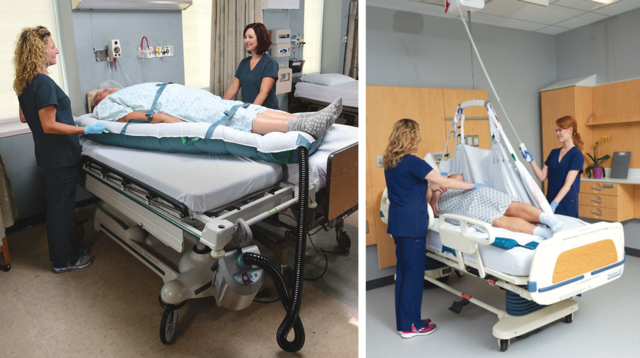
The HoverSling Repositioning Sheet is designed to take convenience and efficiency to the next level by combining the air-assisted benefits of the HoverMatt with a lift sling. Highly breathable fabric allows the HoverSling to be left under the patient so it is always ready for caregivers to use for air-assisted transfers and positioning or with a ceiling lift for turning and vertical lifts. The HoverSling offers the patient exceptional comfort, while preserving dignity by assisting caregivers to make patient handling a minimally disruptive experience.
Interface
Premium rubber flooring, like that manufactured by nora by Interface, provides exceptional in-room noise reduction as compared to other flooring products, fostering a quiet environment for patient recovery. Its non-porous surface also boasts a low-maintenance cleaning regiment, requiring little more than a mop and water, and no stripping or harsh chemicals. This allows staff to prepare patient rooms in half the time without sacrificing hygienic requirements or the perception of cleanliness.
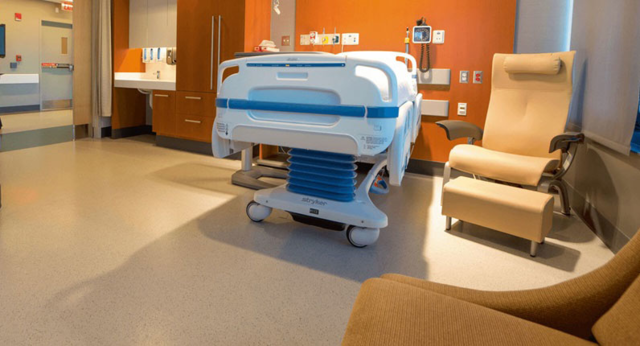
With a cushioned, slip-resistant surface, premium rubber flooring also supports patient and staff safety by reducing preventable slip, trip and fall incidents. That resilient, seamless surface is also built to withstand wear and tear and stand up to high impact activity, so rolling medical equipment glides with ease. Overall, the right flooring can positively impact patient satisfaction, operational optimization, clinical efficiency and safety.
LG
The TV represents a multifaceted vehicle for patient comfort, recovery and convenience and not just an entertainment device.
LG Electronics works closely with the nation's top Healthcare Systems Integration (SI) Partners, including Aceso, GetWellNetwork, MDM, Sonifi, Telehealth and TVR. These companies develop custom options that can be as simple and tailored as the hospital would like them to be. They may also utilize custom overlays for the pillow speakers or keyboards, etc. These companies are part of the LG Healthcare Advisory Board with the goal of improving LG's Pro:Centric platform. These SI partners then develop patient engagement solutions for use on LG's Pro:Centric Smart TVs with the most intuitive graphical user interface (GUI). Although they are competitive solutions, they provide different options and variety to the industry. Those solutions are then implemented with confidence that they will function as planned, improving the patient room experience.
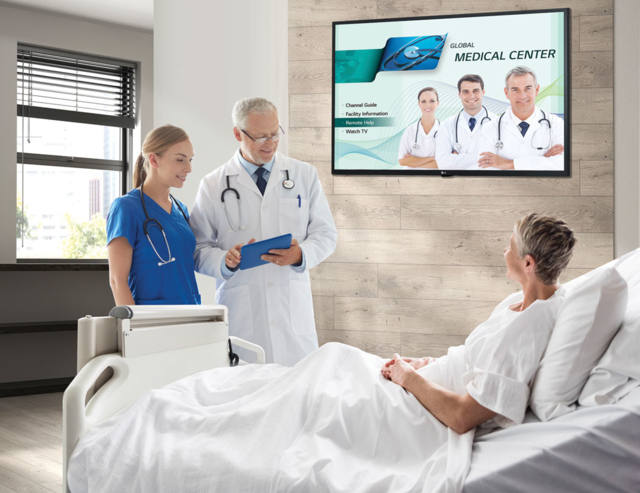
Midmark
The Midmark 626 Barrier-Free Examination Chair is the first and only exam chair of its kind designed to promote proper patient positioning for a more accurate blood pressure measurement. The exam chair allows clinicians to standardize proper patient positioning – setting the foundation for better point of care diagnosis, patient risk stratification and medication dosing. The exam chairs allow 97 percent of the adult population to be seated in a proper position – with feet flat on the floor and back supported. In addition, the chair provides the industry's lowest seat height and a wide, flat transfer surface to enable patients to transfer onto and off of the exam chair with minimal assistance to benefit both the patient and provider.
Midmark worked with more than 20 facilities across the U.S. to create the only mobile workstations that can support the height requirements of 95 percent of users in the clinical setting. The workstations are intuitive for the user, support the deployment of technology at the point of care, and properly support the provider-patient interaction and the clinical workflow. Midmark Workstations also offer an intuitive guidance label and lever to allow for an easily adjustable workstation height that requires little force; easy vertical adjustment to promote proper posture with neck, shoulder, arm and wrist alignment; 180 degrees of left-to-right monitor rotation to promote content sharing and continuous eye contact for provider and patient; and configurations for PC, laptop or tablet applications as well as optional accessories for scanners, printers and other needs.
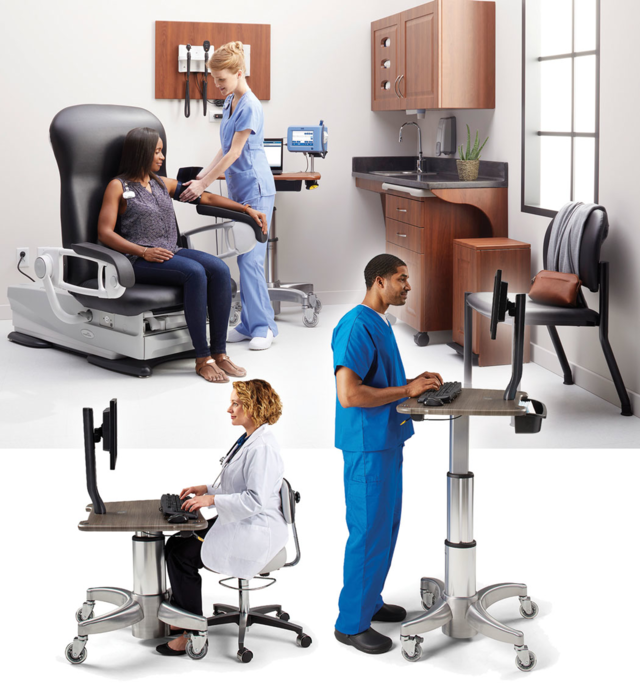
Midmark RTLS can help connect technology, equipment and the EMR to improve the clinical care environment at the point of care and beyond. The Patient Flow Optimization for Clinics solution from Midmark helps health systems optimize patient flow in ambulatory care clinics and ease into the benefits of real-time location systems (RTLS). This workflow solution helps organizations rethink patient flow, reduce patient wait times and increase capacity in outpatient clinics.
PDi Communication Systems Inc.
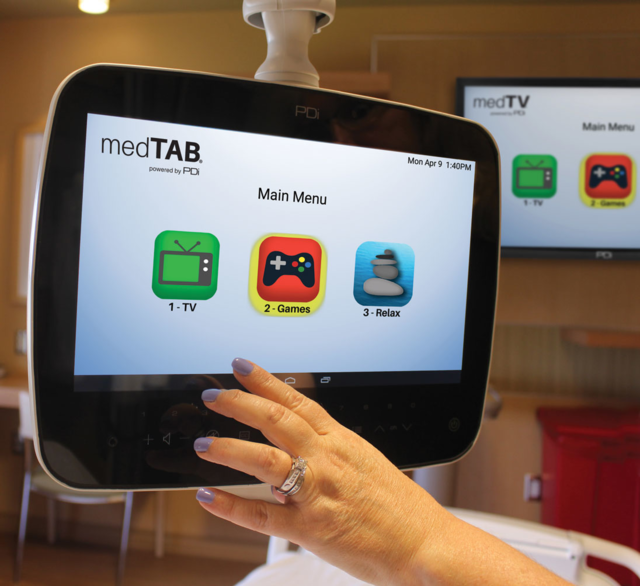 medTV, powered by PDi, delivers comforts of modern-day home entertainment to the patient's bedside. Patients can enjoy more than TV channels as they heal on displays from 14-inch touchscreens through 55-inch Smart wall TVs.
medTV, powered by PDi, delivers comforts of modern-day home entertainment to the patient's bedside. Patients can enjoy more than TV channels as they heal on displays from 14-inch touchscreens through 55-inch Smart wall TVs.
medTAB provides built-in TV, games and relaxation apps; or facilities can choose to allow access to web browsing and connectivity to social sites. This on-demand interactive entertainment can be customized to expand links to patient education, feedback surveys, facilities services such as meal ordering, movies and more. All built for stringent UL healthcare-grade safety standards.
medTAB personal arm-mounted devices are designed and built for patient safety, as they are securely mounted, continuously powered and have antimicrobial coatings to resist the spread of infections. Conveniently located at the bedside, mounted to the headwall, ceiling, floors, counters and more, medTAB TV-tablets offer greater comfort to patients and visitors, while being easy to push out of the way for clinicians. With an easy icon-based user interface, similar to a smartphone, this touchscreen system is easy to operate by patients of all ages. The complete medTAB system provides comfort, control and convenience to the patient and improves patient experience. medTAB and medTV devices are engineered to be backwards-compatible, so facilities that currently have a complete arm system can leverage their existing investment while upgrading to the newest technology.
Sherwin-Williams
Sherwin-Williams offers a comprehensive line-up of coatings designed for the healthcare industry. For a quick view of select paint system recommendations by area, see Healthcare Facility Guide Specification.
A few products that work well for healthcare, include:

Paint Shield Interior Latex Microbicidal Paint
- First EPA-registered microbicidal paint that kills greater than 99.9% of Staph (Staphylococcus aureus), MRSA (Methicillin-resistant Staphylococcus aureus), E. coli (Escherichia coli), VRE (Vancomycin-resistant Enterococcus faecalis), and Enterobacter aerogenes within 2 hours of exposure on a painted surface.
- Continues to kill these disease-causing bacteria for up to 4 years when the integrity of the surface is maintained.
- Available in approximately 550 colors in our popular eg-shel finish.
- Has achieved GREENGUARD GOLD Certification.*
Harmony Zero VOC Interior Acrylic Latex
- Contains odor eliminating technology† to help reduce common indoor odors so that rooms stay fresher longer.
- Delivers very good hide and withstands frequent washings.
- Anti-microbial agents inhibit the growth of mold and mildew on the paint surface.
- Formaldehyde reducing technology helps promote better indoor air quality by reducing VOCs from possible sources like insulation, carpet, cabinets and fabrics.
- Has achieved GREENGUARD GOLD Certification.*
ProMar® 200 HP VOC Interior Acrylic
- Total package for projects that require greater durability, abrasion resistance, and outstanding hide.
- Designed to meet MPI compliance in key categories, including High Performance Architectural.
- Complies with LEED
- Has achieved GREENGUARD GOLD Certification.*
Colors from the Sherwin-Williams 2020 Colormix Forecast Haven palette, which are inspired by the Earth's seasonal cycles, such as Beige Intenso SW 9096, Acacia Haze SW 9132 and Stardew SW 9138, all reflect the subtle shades of the sea, sand, forest and sky. These colors provide a welcoming backdrop to a patient room and pair seamlessly with a variety of flooring, upholstery fabrics and laminates.
The 2020 Colormix Forecast Play palette creates a positive distraction by selecting a few bright pops of color, such as Eros Pink SW 6860 or Aquarium SW 6767.
The 2020 Colormix Forecast Alive palette, including Sleepy Blue SW 6225, Cavern Clay SW 7701 or Endless Sea SW 9150 can provide a powerful dose of color in any area and would be a perfect backdrop for a piece of artwork.
USAI Lighting
Color Select is a tunable white light LED downlight that can change color from daylight to candlelight and everything in between, and can recreate the feel of natural daylight for circadian rhythm lighting needs.
ColorID Content Library represents a collection of pre-programmed, curated lighting scenes developed in collaboration with designers, thought leaders and highly esteemed research institutions. This lighting content library is carefully formulated to support individual lifestyles, work, play, health and wellness – offering an ideal lighting option for every task and moment.
Color Select and the ColorID Content Library can be managed through ColorID Controller, which features one-touch access to the ColorID Content Library scenes. The controllers come pre-loaded with a selection of expertly curated light scenes and a 24-hour circadian program that mimics the sun's light cycle.

About the Author
Rick Dana Barlow
Senior Editor
Rick Dana Barlow is Senior Editor for Healthcare Purchasing News, an Endeavor Business Media publication. He can be reached at [email protected].






